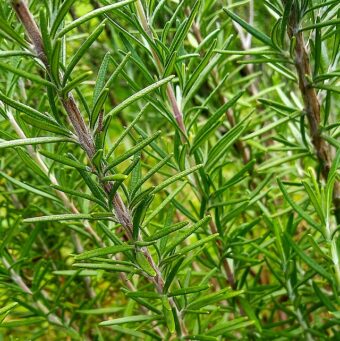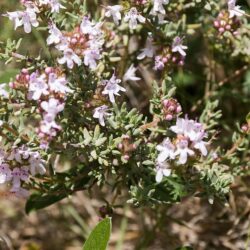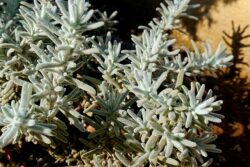In this article, we will discuss the familiar and useful herb plant of Rosmarinus and how to grow them in containers. Although Rosmarinus is no longer a genus recognized on its own because of taxonomic evidence and it has been moved to the larger Salvia genus.

They are small, woody, perennial shrubs and herbs that have fragrant, evergreen, needle-like leaves and it belongs to the Lamiaceae (the Sage) family. They tend to be found in the Mediterranean areas of Europe and Asia, where it is found growing everywhere. The most common species that is found in a lot of gardens are Salvia rosmarinus (Syn. Rosmarinus officinalis) which grows up to 1.5m tall and has grey-green, needle-like leaves above and a powdery white below. In spring, pale-blue flowers appear in clusters along the stems.
Alternatively, there is Salvia jordenii (Syn. Rosmarinus ericocalyx) which tends to have large, vivid, blue flowers with densely haired stems. It is naturally found growing in Northwest Africa and Southern Spain. The leaves are smaller and the plant tends to prostrate.
Rosemary is used to flavour a lot of dishes such as roast lamb, potatoes and tomato dishes.
Another recognized species is Salvia granatensis (Syn. Rosmarinus tomentosus) whose leaves tend to be shorter and rounder than the other Salvia species but are still needle-like in shape.
Rosemary, although used preliminary as a herb, has its uses as part of a container display of shrubs, due to its upright growing habit and masses of small blooms that they produce. Another plus is that it is easy to grow and will flower in most types of soils. Where it will make an excellent foil with more colourful plants.
Find out how to grow this wonderful shrub of Rosmarinus in containers in this article.
GROWING ROSMARINUS IN CONTAINERS
Rosemary likes to be grown in free-draining soil or compost. First, choose a large enough container, a 30cm diameter pot or larger is ideal. You will need to make sure it has plenty of drainage holes at the bottom to allow any excess water to drain out. In the container, add a 5cm layer of coarse gravel to aid drainage even further and to prevent the holes from becoming blocked. Create a free-draining growing media by mixing 70% by volume of multipurpose compost with 30% by volume of washed building sand. Add this to the container to within 5cm of the top rim.

Dig a hole at the centre of the container that is slightly bigger than the root ball it came in the original pot you bought it in. Place the plant in so that the top of the root ball is at the same level as the top surface of the compost in the container. Backfill with the growing media so that no visible gaps remain, using more compost if you find it necessary. Firm it in well and water to allow the roots and compost to settle.
THE BEST GROWING CONDITIONS
It is best to grow in full sun as they will live to their full potential. Ideally, you will place the container near the front door, where you can pick the leaves when you need them and you can enjoy the scent.
Once established it will take drought pretty well but until then water when 5cm below the top surface of the compost feels dry to the touch. They do not like to feel wet at the feet, which could lead to root rot and death of the plant.

They are not hungry plants but you can give an annual dressing of slow-release, general-purpose fertilizer at half its recommended strength in spring.
To prune all you need to do is trim the bush lightly with garden shears as soon as flowering is over in spring. Over time it can become woody with age and may need to be replaced every 5 years or so.
Propagation is via semi-ripe cuttings taken in summer and planted in pots in a cold frame. Allow the plants to grow on and establish before planting out the following year.
PESTS AND DISEASES
In terms of pests, the Rosemary beetle can be a problem. It is best to remove them by hand once observed. They do not suffer readily from known diseases, although it is suspected that Rosemary could be a carrier of Xylella fastodiosa, a bacterial pathogen.
VARIETIES TO GROW
The main species that is widely available and still sold is Salvia rosmarinus, which has been described in great detail in the introduction. There are several varieties available including ‘Aureus’ with white flowers and ‘Variegatus’ that have leaves with splashes of yellow.
The firm favourite is the blue flowering and erect ‘Mrs Jessop’s Upright’. For bright blue flowers and dark green leaves ‘Bowenden Blue’ is the variety to go for.
If you like pink flowers ‘Majorcan Pink’, ‘Pink Flowered’ or ‘Roseus’ are the go-to varieties.
For compact varieties include ‘Severn Sea’, ‘Tuscan Blue , ‘Roman Beauty’ and the prostrating ‘Prostratus’
CONCLUSIONS
In this article, we have discussed how to grow the colourful and useful herb shrub of Rosmarinus in containers. They not only look good, flower prolifically and have leaves that gleam in the sunlight, they are useful too. They are easy to look after, easy to care for and very useful to have in the container garden.
Why not grow one today?
If you have any questions or comments that you wish to make on growing Rosmarinus in containers, please do so in the comment box below.
Happy Rosmarinus growing.
